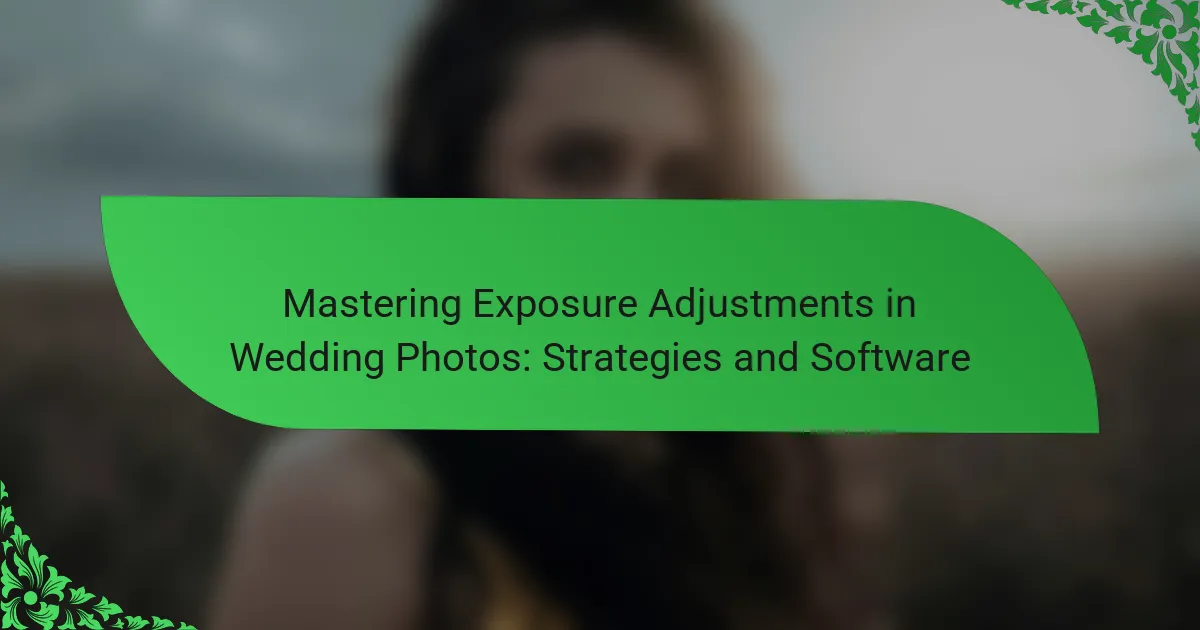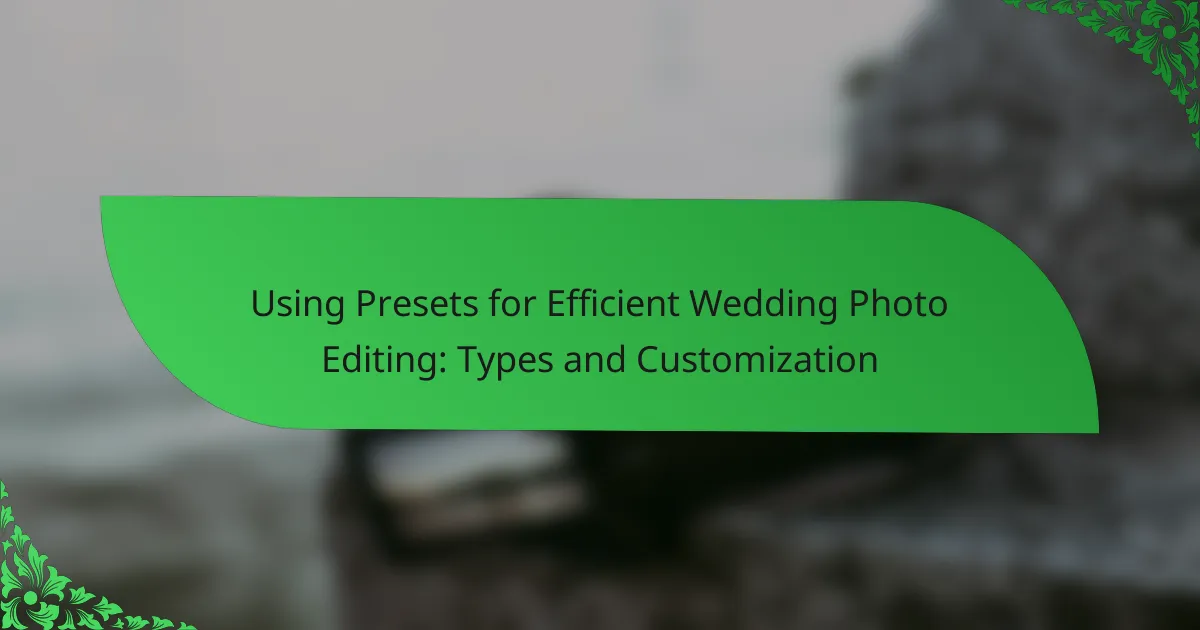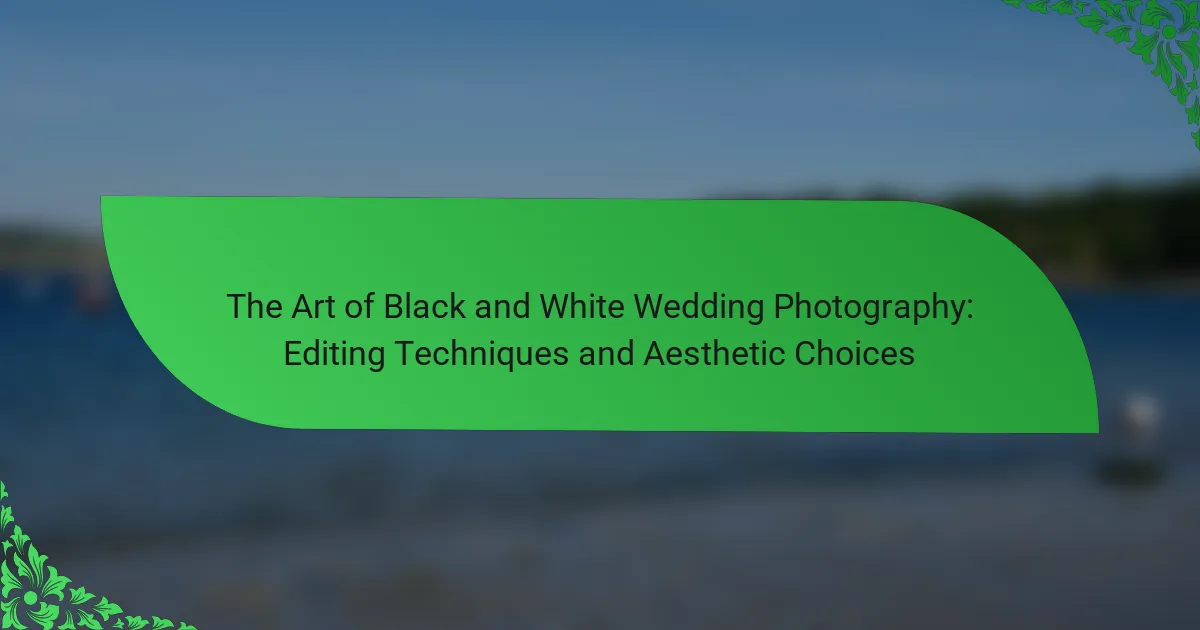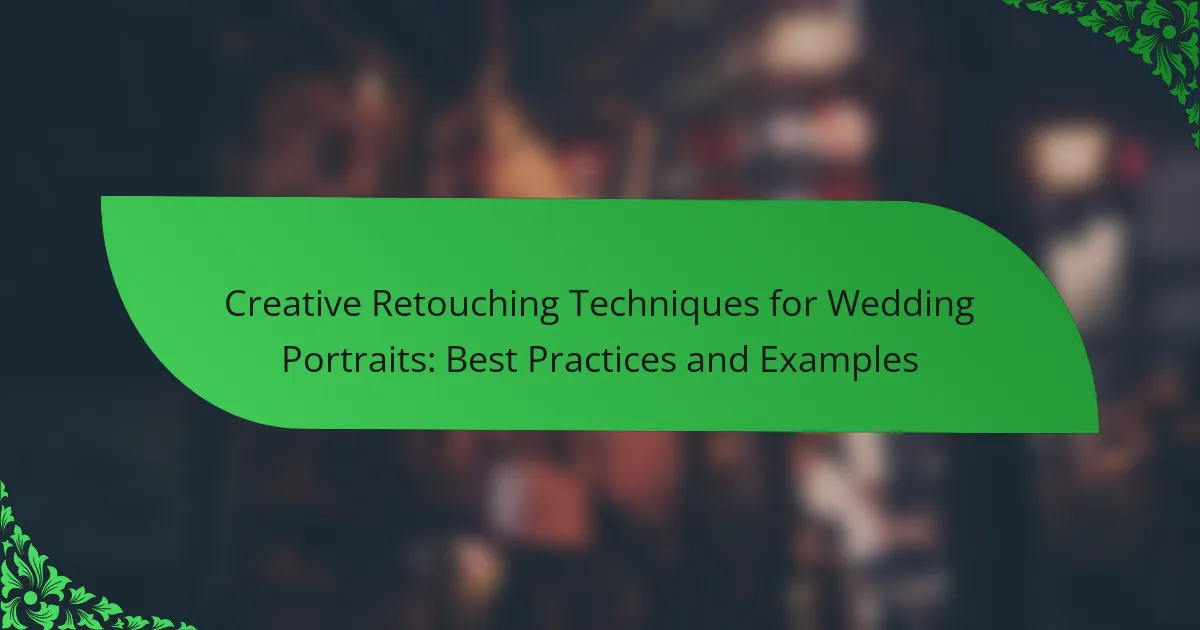Exposure adjustments in wedding photography involve modifying camera settings—aperture, shutter speed, and ISO—to achieve optimal brightness in images. These adjustments are essential for capturing details in varying lighting conditions, such as bright outdoor settings or dimly lit venues. The article outlines effective strategies for making exposure adjustments, including using manual mode, evaluating histograms, and employing exposure compensation. It also highlights software tools like Adobe Lightroom, Capture One, and Photoshop that assist photographers in fine-tuning exposure for enhanced image quality. By mastering these techniques and tools, wedding photographers can significantly improve their photographic outcomes.
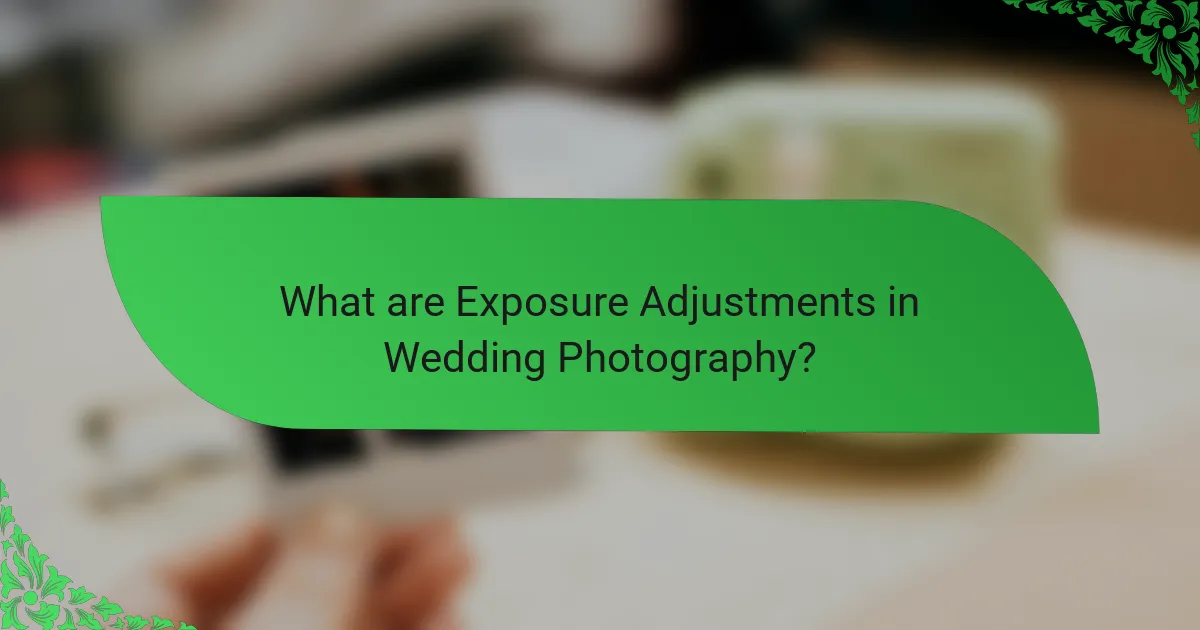
What are Exposure Adjustments in Wedding Photography?
Exposure adjustments in wedding photography refer to the modifications made to the exposure settings of a camera to achieve the desired brightness in images. These adjustments can include changing the aperture, shutter speed, and ISO settings. Proper exposure is crucial for capturing the details in highlights and shadows. In wedding photography, varying lighting conditions often necessitate these adjustments to maintain image quality. For instance, a bright outdoor setting may require a faster shutter speed to prevent overexposure. Conversely, dimly lit venues may need a higher ISO to capture sufficient light without motion blur. Photographers often use exposure adjustments to create a specific mood or to emphasize certain elements in a scene.
Why is Exposure Important in Wedding Photos?
Exposure is important in wedding photos because it directly affects the image’s brightness and detail. Proper exposure ensures that highlights and shadows are balanced. This balance captures the atmosphere of the event accurately. Overexposure can result in loss of detail in bright areas. Underexposure can lead to dark images lacking clarity. Correct exposure enhances skin tones and colors in the photos. It also allows for better post-processing flexibility. Accurate exposure contributes to the overall quality of the wedding album.
How does exposure affect the overall quality of wedding images?
Exposure directly affects the overall quality of wedding images by determining the brightness and detail captured. Proper exposure ensures that highlights and shadows are balanced, enhancing the image’s depth. Underexposed images can appear dark and lack detail, while overexposed images may lose highlights, resulting in a washed-out look. The ideal exposure captures the full dynamic range of the scene, preserving details in both bright and dark areas. This balance contributes to the emotional impact of wedding photos, making them more visually appealing. Studies show that well-exposed images are more likely to evoke positive responses from viewers, reinforcing their significance in capturing memories.
What are the common challenges photographers face with exposure?
Photographers commonly face challenges with exposure due to varying lighting conditions. Inconsistent natural light can cause overexposure or underexposure. Indoor venues may have mixed lighting sources, complicating exposure settings. Fast-moving subjects can lead to missed shots if exposure is not adjusted quickly. High dynamic range scenes can result in lost detail in highlights or shadows. Additionally, relying on automatic settings may not yield the desired results. Understanding the exposure triangle is essential for overcoming these challenges. Photographers often need to adjust aperture, shutter speed, and ISO to achieve proper exposure.
What are the Key Elements of Exposure in Photography?
The key elements of exposure in photography are aperture, shutter speed, and ISO. Aperture controls the amount of light entering the camera. It also affects depth of field. Shutter speed determines how long the camera’s sensor is exposed to light. Faster shutter speeds freeze motion, while slower speeds create motion blur. ISO measures the sensor’s sensitivity to light. Higher ISO settings allow for shooting in low light but can introduce noise. These three elements work together to create a well-exposed image. Understanding their interaction is crucial for achieving desired photographic results.
What role do ISO, shutter speed, and aperture play in exposure?
ISO, shutter speed, and aperture are crucial elements that control exposure in photography. ISO measures the camera sensor’s sensitivity to light. A higher ISO allows for better performance in low-light conditions but can introduce noise. Shutter speed determines how long the camera’s shutter is open to let light in. Faster shutter speeds freeze motion, while slower speeds can create motion blur. Aperture controls the size of the lens opening, affecting the amount of light entering the camera. A wider aperture allows more light and creates a shallow depth of field, while a smaller aperture lets in less light and increases depth of field. Together, these three settings form the exposure triangle, balancing light and image quality for optimal results in photography.
How can understanding these elements improve wedding photography?
Understanding exposure adjustments enhances wedding photography by ensuring optimal image quality. Proper exposure balances light, preventing overexposure or underexposure. This balance captures details in highlights and shadows, resulting in more dynamic images. Mastering exposure techniques can also improve color accuracy, making skin tones appear natural. Additionally, using software for exposure adjustments allows photographers to correct mistakes in post-processing. Studies show that well-exposed images receive higher engagement rates on social media, emphasizing the importance of these skills. Overall, understanding exposure elements leads to more visually appealing and professional wedding photos.
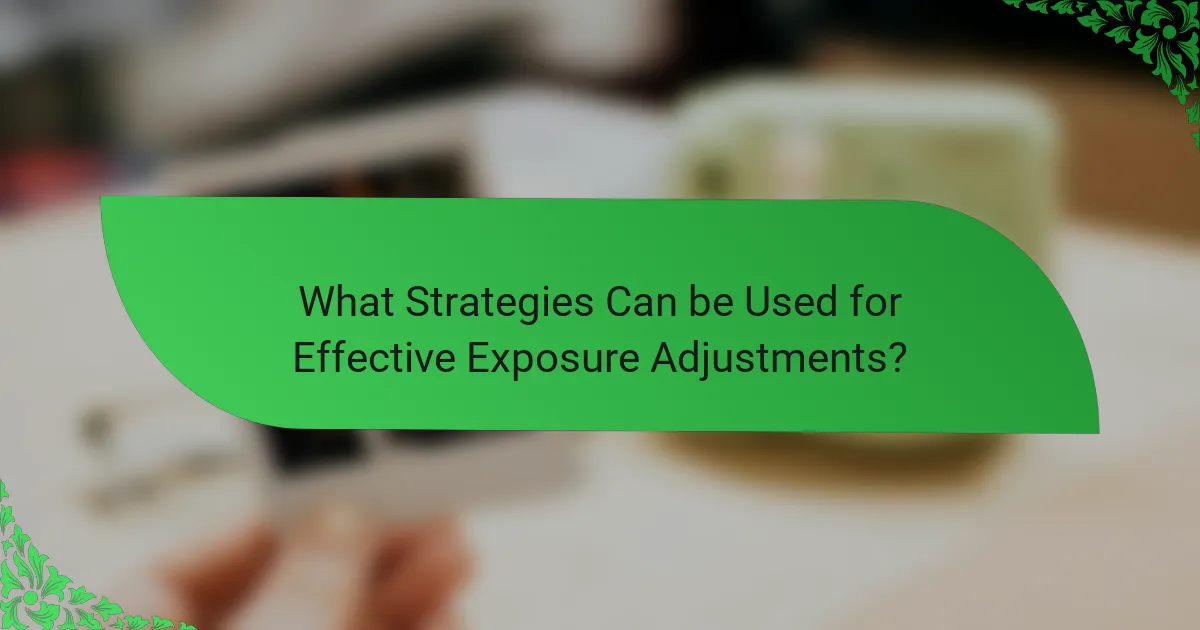
What Strategies Can be Used for Effective Exposure Adjustments?
Effective exposure adjustments can be achieved through several strategies. First, use manual mode on your camera to control aperture, shutter speed, and ISO. This allows for precise adjustments based on lighting conditions. Second, evaluate the histogram to ensure proper exposure levels. A balanced histogram indicates well-exposed images. Third, utilize exposure compensation to correct for tricky lighting scenarios. This feature adjusts the exposure level without changing the camera settings. Fourth, consider bracketing exposures to capture multiple images at different exposure levels. This technique ensures one image is correctly exposed. Fifth, employ post-processing software to fine-tune exposure after the shoot. Programs like Adobe Lightroom offer tools for adjusting highlights, shadows, and overall exposure. These strategies collectively enhance the quality of wedding photos by ensuring optimal exposure.
How can photographers assess lighting conditions at a wedding?
Photographers can assess lighting conditions at a wedding by evaluating the available light sources and their intensity. They should observe the natural light at different times of the day. Photographers can use a light meter to measure the light levels accurately. They should also consider the color temperature of the light, which affects the mood of the photos. Additionally, they can take test shots to analyze exposure settings. Adjusting camera settings based on these observations ensures proper exposure. Using on-camera histogram displays provides immediate feedback on exposure accuracy. These methods help photographers adapt to varying lighting conditions throughout the event.
What techniques can help in balancing exposure in challenging lighting?
Techniques to balance exposure in challenging lighting include using exposure compensation, adjusting ISO settings, and employing graduated neutral density filters. Exposure compensation allows photographers to manually adjust the exposure level, ensuring brighter or darker images as needed. Adjusting ISO settings helps to manage the camera’s sensitivity to light, which can improve image quality in low-light situations. Graduated neutral density filters reduce the intensity of light in specific areas of an image, effectively balancing bright skies with darker landscapes. These techniques are essential for achieving well-exposed wedding photos under varying lighting conditions.
How can photographers use reflectors and diffusers for better exposure?
Photographers can use reflectors and diffusers to achieve better exposure by controlling light. Reflectors bounce light onto subjects, filling in shadows. This creates a more balanced exposure. Diffusers soften harsh light, reducing contrast. This helps prevent overexposed highlights and underexposed shadows.
Using a reflector can enhance skin tones in portraits. A silver reflector increases brightness, while a gold reflector adds warmth. Diffusers can be placed between the light source and the subject. This technique is especially useful in direct sunlight.
Studies show that proper light manipulation improves image quality. A well-exposed photo enhances details and colors. Photographers often use these tools to achieve professional results.
What are the Best Practices for Adjusting Exposure in Real-Time?
The best practices for adjusting exposure in real-time include using histogram displays and adjusting camera settings promptly. Histograms provide a visual representation of exposure levels. They help photographers identify underexposed or overexposed areas instantly. Adjusting ISO, aperture, and shutter speed in tandem can enhance exposure effectively. For example, increasing ISO can brighten images without altering shutter speed. Additionally, using exposure compensation allows fine-tuning of brightness levels quickly. Utilizing live view mode can also assist in making real-time adjustments based on immediate feedback. These methods are crucial for capturing well-exposed wedding photos in varying lighting conditions.
How can photographers quickly adjust settings during a wedding shoot?
Photographers can quickly adjust settings during a wedding shoot by using camera features like auto ISO, exposure compensation, and custom presets. Auto ISO allows the camera to automatically adjust sensitivity to light, ensuring proper exposure in changing lighting conditions. Exposure compensation enables photographers to quickly alter brightness without changing the aperture or shutter speed. Custom presets save specific settings for different lighting situations, allowing for instant adjustments. Additionally, photographers can utilize their camera’s quick menu for fast access to frequently used settings. These strategies help maintain optimal exposure while capturing dynamic wedding moments.
What tips can help in achieving consistent exposure throughout the event?
To achieve consistent exposure throughout the event, use manual settings on your camera. This allows you to control aperture, shutter speed, and ISO effectively. Set a baseline exposure at the beginning of the event. Adjust your settings only when lighting conditions change significantly. Use a gray card to ensure accurate white balance, which helps maintain exposure consistency. Monitor your histogram frequently to avoid overexposure or underexposure. Additionally, consider using exposure bracketing to capture a range of exposures for critical moments. Finally, utilize post-processing software to fine-tune exposure in editing, ensuring a cohesive look across all images.
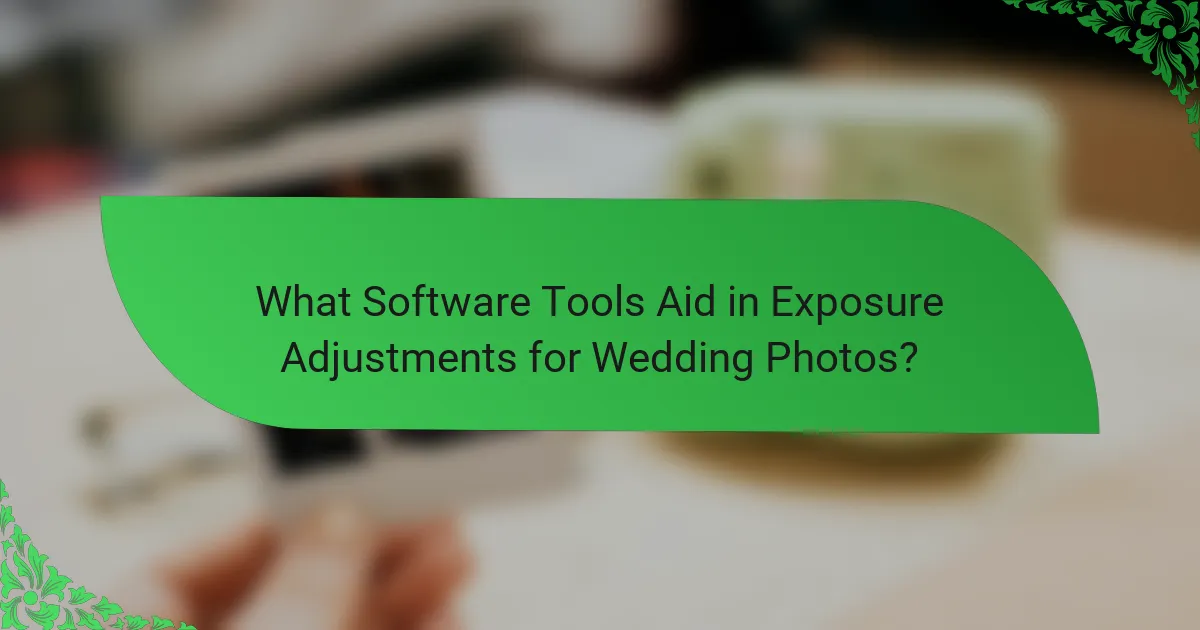
What Software Tools Aid in Exposure Adjustments for Wedding Photos?
Adobe Lightroom aids in exposure adjustments for wedding photos. It offers tools for adjusting brightness, contrast, and highlights. Photographers can easily manipulate exposure settings using sliders. Capture One is another software that provides advanced color grading and exposure control. It allows for precise adjustments to shadows and highlights. Photoshop is also commonly used for fine-tuning exposure in wedding images. Its layers and masks enable targeted exposure corrections. Additionally, ON1 Photo RAW offers a range of exposure adjustment options with an intuitive interface. These tools are widely recognized in the photography community for their effectiveness in enhancing wedding photos.
Which software options are best for post-processing wedding photos?
Adobe Lightroom is one of the best software options for post-processing wedding photos. It offers powerful tools for color correction, exposure adjustments, and batch processing. Photographers can easily organize and manage large volumes of images. Capture One is another excellent choice, known for its advanced color grading and tethering capabilities. It provides a high level of control over image details. Photoshop is also widely used for detailed retouching and compositing. It allows for intricate edits that enhance the overall quality of wedding photos. Each of these software options is popular among professional photographers for their unique features and capabilities.
How does Lightroom assist in exposure adjustments?
Lightroom assists in exposure adjustments by providing intuitive tools for modifying image brightness. Users can adjust the exposure slider to increase or decrease overall brightness. The program also includes options for highlights, shadows, whites, and blacks, allowing for targeted adjustments. This granularity helps in recovering details in both bright and dark areas of the image. Lightroom’s histogram displays real-time feedback on exposure levels as adjustments are made. Additionally, it offers presets and profiles for quick exposure corrections. These features streamline the editing process, making it efficient for wedding photographers to achieve desired exposure.
What features of Photoshop can enhance exposure corrections?
Photoshop offers several features that enhance exposure corrections. The ‘Levels’ adjustment allows precise control over shadows, midtones, and highlights. This feature helps in redistributing brightness levels effectively. The ‘Curves’ adjustment provides a more advanced method to manipulate tonal ranges. Users can create custom curves for targeted exposure adjustments. The ‘Exposure’ adjustment layer specifically allows for overall exposure changes. It can increase or decrease exposure values with a slider. The ‘Shadows/Highlights’ adjustment helps recover details in both bright and dark areas. This feature is particularly useful for wedding photos with varied lighting. The ‘Brightness/Contrast’ adjustment offers basic exposure changes. It is ideal for quick fixes in images. The ‘Camera Raw’ filter provides comprehensive exposure control options. It allows for adjustments in a non-destructive way. These features collectively enable photographers to achieve balanced and well-exposed images.
How can photographers choose the right software for their needs?
Photographers can choose the right software by assessing their specific needs and workflow. They should identify the types of edits they frequently perform. Common tasks include color correction, retouching, and organization. Photographers should also consider the software’s compatibility with their camera formats. User interface and ease of use are important for efficiency. Additionally, they should evaluate the software’s features against their budget. Many software options offer trial versions for testing. Reviews and recommendations from other photographers can provide valuable insights.
What factors should be considered when selecting photo editing software?
When selecting photo editing software, consider compatibility with your operating system. Ensure the software supports your device, whether Windows or Mac. Evaluate the user interface for ease of use. A straightforward interface can enhance your editing efficiency. Look for features that meet your editing needs. Essential tools include color correction, cropping, and retouching. Assess the software’s performance speed. Faster software allows for a smoother workflow. Check for customer support and resources. Good support can assist with troubleshooting and learning. Finally, compare pricing and subscription models. Choose software that fits your budget while providing necessary features.
What are Practical Tips for Mastering Exposure Adjustments?
To master exposure adjustments, use the histogram to assess exposure levels accurately. The histogram visually represents light distribution in your image. Aim for a balanced histogram without clipping highlights or shadows. Adjust your camera settings, such as ISO, aperture, and shutter speed, to achieve the desired exposure. Utilize exposure compensation to fine-tune brightness in tricky lighting conditions. Practice with different lighting scenarios to understand how they affect exposure. Use software like Adobe Lightroom for precise adjustments post-shooting. This software allows for fine-tuning exposure, contrast, and highlights effectively. Regular practice and experimentation will enhance your skills in exposure adjustments.
How can continuous learning improve a photographer’s exposure skills?
Continuous learning enhances a photographer’s exposure skills by providing updated techniques and insights. Photographers can explore new methods for managing light and shadow. They can learn about advanced camera settings and their effects on exposure. Workshops and online courses offer practical exercises to practice these skills. Feedback from peers and mentors can guide improvement in exposure techniques. Staying informed about technological advancements helps photographers adapt to new equipment. Research indicates that ongoing education leads to increased confidence and creativity in photography. Ultimately, continuous learning fosters a deeper understanding of exposure, resulting in better wedding photos.
What resources are available for photographers looking to enhance their knowledge on exposure adjustments?
Online courses are available for photographers to enhance their knowledge on exposure adjustments. Platforms like Udemy and Coursera offer specialized courses in photography. These courses cover exposure techniques, camera settings, and practical assignments. Additionally, photography blogs and websites provide tutorials and articles focused on exposure adjustments. Books on photography, such as “Understanding Exposure” by Bryan Peterson, also serve as valuable resources. YouTube channels dedicated to photography offer visual demonstrations of exposure adjustments in various settings. Finally, online forums and photography communities allow photographers to share experiences and ask questions about exposure techniques.
Mastering Exposure Adjustments in Wedding Photos focuses on the critical role of exposure in capturing high-quality wedding images. The article outlines essential concepts such as the exposure triangle—aperture, shutter speed, and ISO—and discusses their impact on image brightness and detail. It also addresses common challenges photographers face with varying lighting conditions and offers strategies for effective exposure adjustments, including manual settings, histogram analysis, and the use of reflectors and diffusers. Additionally, the article highlights software tools like Adobe Lightroom and Photoshop that aid in post-processing exposure corrections, providing practical tips for photographers to enhance their skills in achieving optimal exposure throughout the wedding event.
